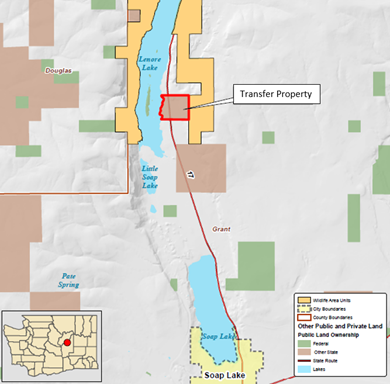
Wildlife Program report: Jun. 1-15, 2023
Providing Recreation Opportunities
Washington Department of Fish and Wildlife (WDFW) closed on the acquisition of 174± acres in Grant County, known as the Lake Lenore property, in Region 2. This property was owned by the Washington State Parks and Recreation Commission (State Parks) yet managed by WDFW. This property was approved through Lands 20/20 in 2019 and by the Commission in December 2020, and was a no-fee transfer from State Parks to WDFW for continued public recreation. This property will be managed as part of the Columbia Basin Wildlife Area and will continue to provide public recreation and water access to Lake Lenore, with the potential to develop a future formal shooting range on the property.

Washington Department of Fish and Wildlife (WDFW) closed on the acquisition of the 94±-acre Nemah Tidelands property in Pacific County, Region 6. This property was approved through Lands 20/20 in 2018 and by the Commission in March 2022 and was acquired at the appraised value of $564,000 using a Washington Wildlife and Recreation Program Water Access grant from the Recreation and Conservation Office. Acquiring this property provides WDFW a unique opportunity to provide direct public access to nearly a mile of Willapa Bay tidelands for shellfish harvest.
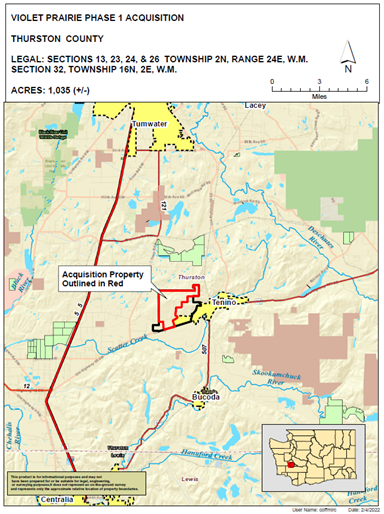
Conserving Natural Landscapes
WDFW closed on the acquisition of a 1,513±-acre property in Douglas County, Region 2, which will be added to the Central Ferry Canyon Unit of the Wells Wildlife Area. This property was approved through Lands 20/20 in 2018 and by the Commission in March 2022 and was acquired at the appraised value of $580,00 using a Cooperative Endangered Species grant from the US Fish and Wildlife Service. This property consists of extensive shrubsteppe habitat for mule deer and Columbian sharptailed grouse, and habitat for the conservation of Columbia Basin pygmy rabbits and Washington ground squirrels.
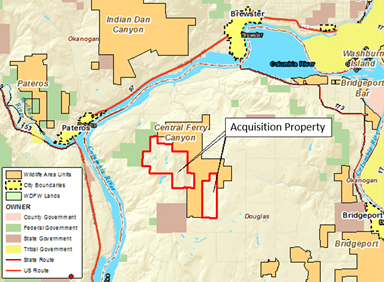
WDFW closed on the first 1,035± acres of a multi-phased property acquisition to acquire a total of 1,567± acres in Thurston County, just west of Tenino, known as the Violet Prairie property. This property was approved through Lands 20/20 in 2016 and by the Commission in March 2022 and was acquired at the appraised value of $7,765,107.06 using a Washington Wildlife and Recreation Program Critical Habitat grant from the Recreation and Conservation Office and two Cooperative Endangered Species grants from the US Fish and Wildlife Service. This property includes intact, prairie-oak woodland and wetland habitat, adds significantly to the protected area of the Scatter Creek watershed, and protects occupied habitat for the federally threatened Mazama pocket gopher, Puget blue butterfly, Taylor’s checkerspot butterfly, and will eventually increase compatible public recreational opportunities.

Cowlitz Wildlife Area Planning: The public scoping phase of the Cowlitz Wildlife Area plan begins in July. A public open house and site visit for the planning team is scheduled for July 11. A field visit is also scheduled for the Cowlitz Wildlife Area Advisory Committee in July.
L.T. Murray Wildlife Area Planning: The final draft of the L.T. Murray Wildlife Area Management Plan was submitted for SEPA review. Public comment begins on Friday, June 16. A public open house will be held at the Armory building at the Kittitas County Fairgrounds in Ellensburg on June 21 from 6-8 p.m.
Skagit Wildlife Area Planning: The draft Skagit Wildlife Area Management Plan is expected to be delivered to nine tribes on June 16 for their review and comment. Staff members have spent a considerable amount of time fine tuning the document. The draft plan will be delivered to the Wildlife Area Advisory Committee and the Diversity Advisory Committee by early July for their review and comment. The SEPA 30-Day public review is expected in August.
Methow Wildlife Area Planning: Planning staff members are working with Region 2 staff members in preparation for a public workshop tentatively to be held on Sep. 13 in Winthrop to discuss winter closures for the protection of mule deer. Discussions with Wildlife Science and Game have been ongoing with the possibility of a research project to measure how the mule deer are responding to the closure.
Providing Education and Outreach
The WDFW Ambassador Program will kick-off in two weeks on July 1. E. Browning and Washington Trails Association, the contractor, are focusing on volunteer recruitment. There are 30 volunteers signed up so far. Meetings with land managers have been very informative in gathering the educational talking points to deliver to the public.
Conducting Business Operations and Policy
Belson collaborated with L. Nelson to complete the DJ-Boating Access grant proposal for Fiscal Year 2023 to 2024.
Other
Management of an ongoing contract with TREAD (Trails, Recreation, Education, Advocacy, and Development) for trail conditions assessment in Quincy Lakes. TREAD has mapped re-routes around culturally sensitive areas and is organizing the data to be inputted into the WDFW database. This is one step in the process of getting trails at Quincy Lakes designated and managed more appropriately.
Managing Wildlife Populations
Bat Acoustic Monitoring: Biologists Lowe and Brinkman deployed acoustic monitoring equipment to survey for bats at four locations in the Mount Spokane area as part of the Pacific Northwest North American Bat Monitoring Program.

Bat Maternity Colony Monitoring: Biologists Lowe and Brinkman, WDFW staff members DeVivo, Westerman, Mackelvie, Wagner, and Lehman, Bureau of Land Management Biologist Lowe, and Washington State University Intern Walters conducted evening emergence counts of four bat maternity colonies in Whitman, Spokane, and Lincoln counties this week.
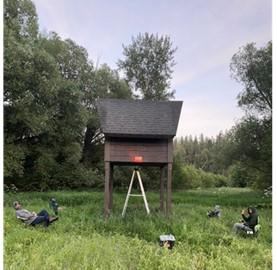
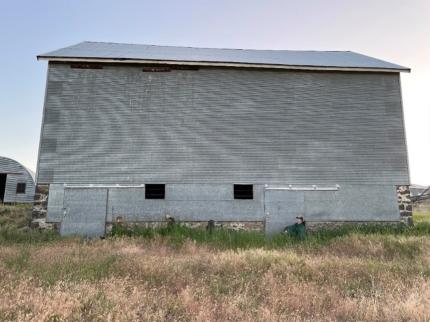
Bumble Bees: Biologists Lowe and Brinkman conducted a second bumble bee survey in Lincoln County as part of the Pacific Northwest Bumble Bee Atlas project. Several different species of bumble bees were captured at the site on Hawk Creek, and most were found using the flowers of hairy vetch.
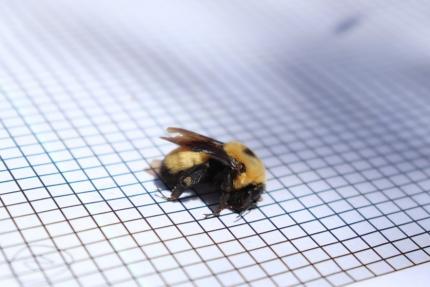
Elk Calf Survival Study: District 3 biologists wrapped up elk calf captures on June 12, having captured 115 elk calves from the ground and helicopter. Numerous other agency staff members and volunteers assisted in this effort that focused on three game management units (GMU) with three capture crew leads continuously working across the landscape. We captured 51 calves during the ground phase of capture operations. District Biologist Wik supervised aerial captures with Leading Edge Helicopters, and they captured 64 calves.
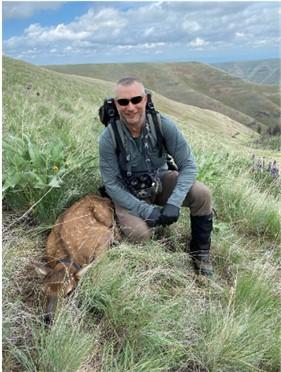
Ferruginous Hawk Monitoring: Assistant District Biologist Vekasy continued the monitoring of historic and recently installed hawk nest platforms for productivity assessment. Vekasy also joined with Research Scientist Watson to radio-tag a ferruginous hawk fledgling. Two transmitters were donated by Northwest Wildlife Consultants, and the Woodland Park Zoo is providing funding for data acquisition. We plan to deploy the 2nd transmitter at a different nest site in the coming week.
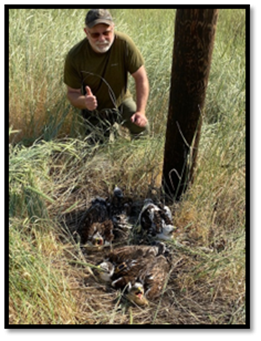
Bat Bridge Monitoring: Assistant District Biologist Vekasy retrieved bat guano collection devices from two bridges in the vicinity of Bureau of Land Management parcels as part of an ongoing bridge monitoring project. One bridge was a repeat sample from last year that was used by bats as a day roost. The newly added bridge had day-roosting bats during the first visit but appeared to be used as a maternity site with hundreds of bats present during sample collection visit.
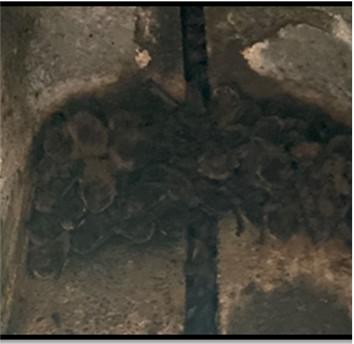
Chronic Wasting Disease: Wildlife Conflict Specialist Kolb collected chronic wasting disease (CWD) samples at roadkill pits in District 3.
Natural Resource Technicians Nizer and Rumiser sampled two roadkill deer in Whitman County for CWD. Samples were taken off Highway 195.
Chronic Wasting Disease Operations: Natural Resource Technician Heitstuman checked local pits for CWD samples.
Bighorn Sheep Survey: Wildlife Biologist Prince and a volunteer surveyed the Vulcan bighorn sheep herd this week. Unfortunately, despite the cool weather, no sheep were observed. Additional surveys will be conducted this summer to, hopefully, observe lambs. It is suspected that this herd declined following the 2021 summer, potentially due to blue tongue.
Bumble Bees: Biologists Lowe and Brinkman conducted another bumble bee survey in Lincoln County as part of the Pacific North West Bumble Bee Atlas project. Several different species of bumble bees were captured at the site near Keller Ferry Campground, and most were found using the flowers of lupine.
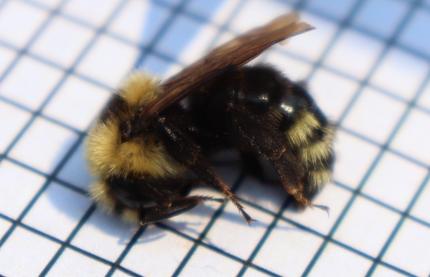
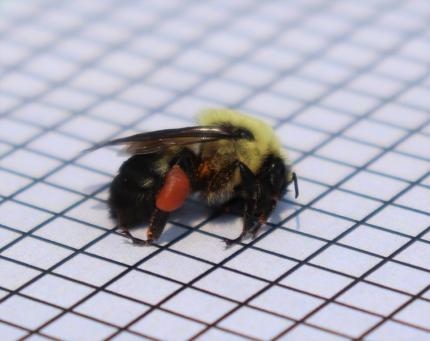
Providing Recreation Opportunities
Trail Maintenance: Sherman Creek Wildlife Area Natural Resources Technician Zueger inspected and mowed the trail that runs from Sherman Creek Wildlife Area headquarters south along the Columbia River towards Haag Cove. She found two downed trees blocking the route on Thursday. Zueger and Wildlife Area Assistant Manager Daro Palmer will remove them next week.
Cooperator Outreach: Natural Resource Technician Harris mailed out pre-hunting season letters to all District 1 private lands hunting access program cooperators.
Access Area Maintenance: Water Access Area Manager Dziekan picked up his repaired water tank and truck with the fixed tire on June 12, and visited his most used water access areas along the Highway 2 and Highway 395 corridors. He found that the Waitts and Loon lakes sites were in dire need of cleaning. Otherwise, the sites were generally in need of cleaning but curiously, relatively trash-free. Dziekan also noted a few sites will need roadside mowing in the near future.

Providing Conflict Prevention and Education
Creston Junior High School Environmental Science Grant: This week in the local Wilbur Register, an article came out in the paper showing the Keller Grade School class coming to the Swanson Lakes Wildlife Area in this year’s Lake Roosevelt Forum Discovery Zone. The Swanson Lakes Wildlife Area has been hosting the annual Discovery Zone for many years.
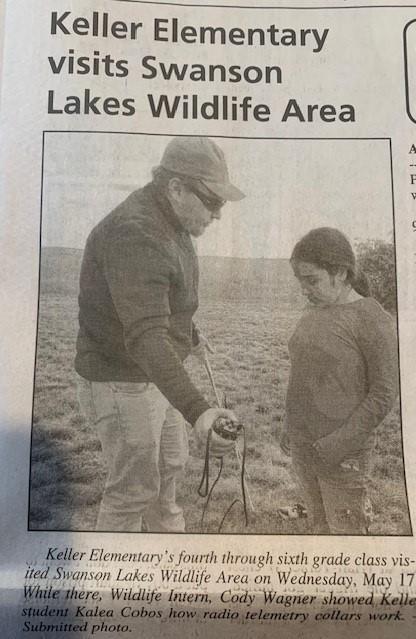
Educational Presentations:Natural Resource Technician Heitstuman attended the Getting Outdoors Educational Day to assist Supervisor Earl in presenting five, 30-minute sessions to groups of 7th and 8th grade students. The interaction Supervisor Earl was able to create with the students was appreciated by all.
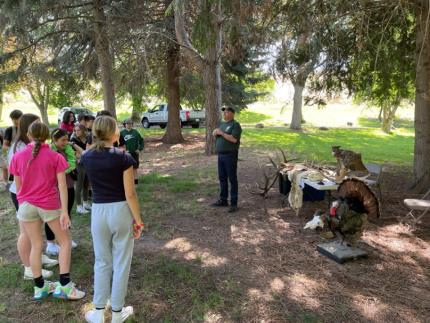
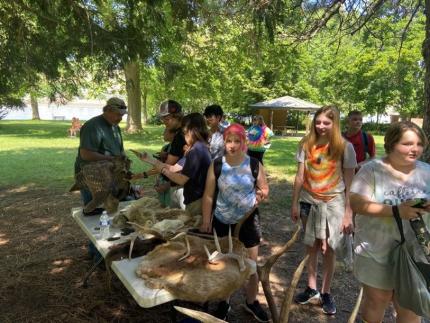
Dayton School Gear-Up Program: Wildlife Area Manager Dingman, Natural Resource Technician Tritt, and Natural Resource Worker Jensen spent time with a group of 9th graders from the Dayton School Gear-Up Program. They talked about their educations and their current jobs, then talked about the wildlife found on the wildlife area and looked at hides and skulls. The kids then planted pine trees and mock orange shrubs in a habitat plot, and each of them got to build a birdhouse to take home with them.
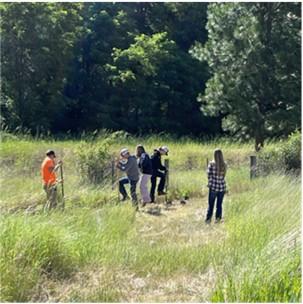
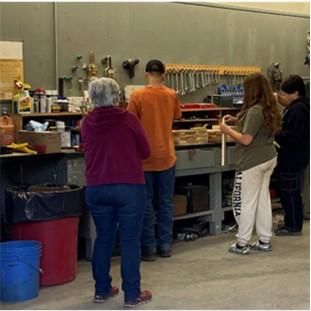
Providing Conflict Prevention and Education
Electric Fence: Wildlife Biologists Prince and Turnock met with a winner of an electric fence giveaway. They took measurements of the fence and decided on materials to be used. WDFW is paying for the fence in an effort to raise awareness for electric fencing for deterring bears with an emphasis on grizzly bears. The winner of the fence attended a WDFW electric fencing clinic at North 40. The clinic was a partnership between the Department, Defenders of Wildlife, Gallagher Fencing, and North 40 Colville.
Asotin County Wolf Activity: Natural Resource Technician Heitstuman went with Area Manager Dice to look at an elk depredation issue in the Chief Joseph Area and to review cattle grazing operation where wolf activity may be occurring. This opportunity was also used to learn the areas where habitat and forage crops for elk are being planted in rotation.
Elk Damage and Hazing: Wildlife Conflict Specialist Kolb and Statewide Human Wildlife Conflict Analysist Todd conducted elk hazing and conflict mitigation in Walla Walla and Columbia counties. Dispersing elk from agricultural crops is nearly impossible until the calves can keep up with the cows.
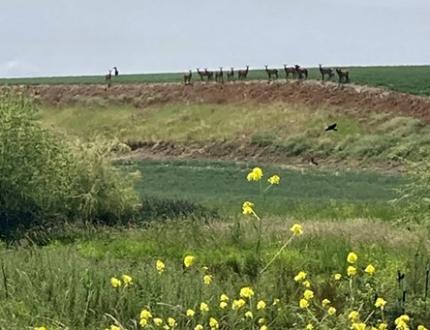
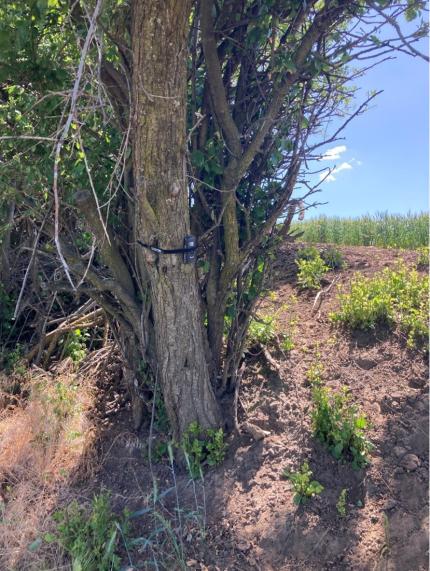
Conserving Natural Landscapes
Turkey Habitat Project: Private Lands Biologist Hadley performed a site visit to a turkey habitat project to spot mow areas of weeds around planted cottonwood trees and then followed up with hand watering the planted cottonwood trees.
Habitat Coordination: Hadley met with a Walla Walla Conservation District planner to discuss continuing a habitat project started last spring in planting additional shrubs as well as having discussions on additional locations of habitat projects.
Conducting Business Operations and Policy
General Facilities and Equipment Maintenance and Repairs: Wildlife Area Assistant Manager Palmer took delivery of a used 2755 John Deere tractor and loader attachment, transferred from the Private Lands section. Palmer fixed a faulty clutch and then used the tractor to fertilize the food plots on Sherman Creek Wildlife Area.
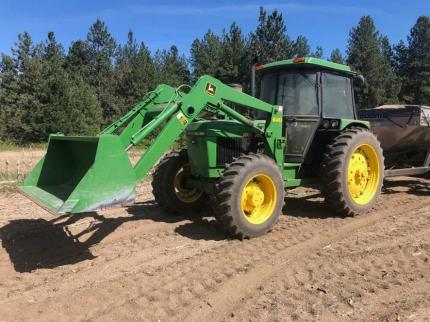
Utility Task Vehicle Training: This week Safety Specialist Mundy came out from the WDFW safety office to teach utility task vehicle training to most of the staff members at Swanson Lakes Wildlife Area and other WDFW staff members within the region. The training was an excellent course to teach skills needed for safe operations. Prior to the class each student had to complete and pass the Recreational Off-Highway Vehicle Association online class and print their certificate.
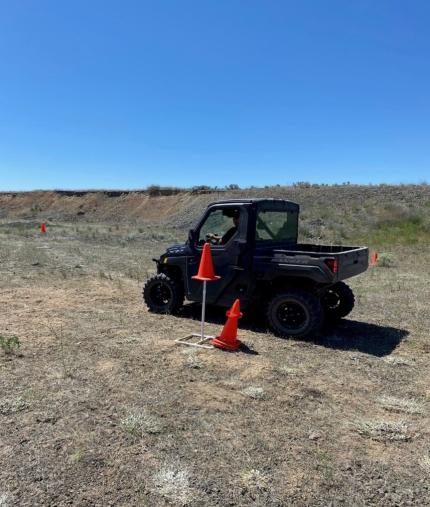
Liberty Lake Senior Fishing: Officer Beauchene hosted a fishing day at the Liberty Lake access area for seniors at a local assisted living home. Dziekan didn’t participate in the event however Dziekan did go out and pick up the area and clean the restrooms to help give them a positive experience. Officer Beauchene has been doing this for a few years now and the folks living at the home look forward to it all year.
WDFW Senior Staff Field Tour: This week, WDFW senior staff met at the Revere Wildlife Area as one of the group’s many stops for the day. One of the highlights of the tour was with Bureau of Land Management (BLM) Spokane District Biologist Lowe explaining the Elk Migration Project. WDFW has been working on the project, for the last couple of years, with the Rock Creek Conservation District and BLM. The goal of the project was to improve the upland and riparian habitat conditions for Rocky Mountain elk and mule deer in the Rock Creek corridor by reducing weeds and establishing vegetation used by big game for forage and cover on 265 acres of the Bureau of Land Management land and 90 acres of WDFW land.
Other
All-Terrain Vehicle Training: Natural Resource Technician Nizer and Natural Resource Technician Rumiser completed an all-terrain vehicle training put on by WDFW at the Chief Joseph Wildlife Area. The training lasted three hours, and there was a field course and a guided ride afterwards.
Gaston Leaving the Agency: Natural Resource Technician Nizer and Private Lands Biologist Gaston organized the office and transferred information that is needed to know for Gaston’s departure from the agency. Nizer and Gaston communicated what needs to be completed in his absence and Nizer will be taking on Gaston’s duties while he is gone. Gaston will be missed dearly by the agency as he was a huge asset to the private lands program in Region 1. His drive and love for hunting access will be missed.
Managing Wildlife Populations
White-tailed Ptarmigan Research: Biologist Heinlen assisted Research Scientist Schroeder with ptarmigan research efforts on Armstrong and Horseshoe mountains in the Pasayten Wilderness. The pair surveyed active male breeding territories and banded eight new birds (four males and four females). Deeper than expected snow conditions precluded camera checks and the retrieval of a transmitter (suspected mortality), so those tasks will wait until later in the summer.
Bat Colony Surveys: Biologist Fitkin assisted Biologist Tobin and the Region 2 Diversity field staff members with bat colony survey work at three sites in the Methow Valley. The team documented over 300 individuals at a large pallid bat colony, 108 individuals at a big brown bat colony, and a handful of individuals (Myotis spp.) at the third site which will be revisited later in the summer in the hope of detecting more activity. This is part of a broader long-term inventory and monitoring effort for bats in Washington.
Fisher Reintroduction Monitoring: Biologists Fitkin and Heinlen with help from Volunteer Fisher (ironic, we know) began retrieving the remote camera sites deployed last fall. This work is part of the North Cascades fisher occupancy monitoring effort following their recent reintroduction. A camera deployed along the Methow River near Mazama detected a fisher this spring. This animal was found in an area where a credible report from a Washington Department of Fish and Wildlife fish biologist had occurred several months earlier. This sighting suggests the fisher is a possible resident animal. As always, the cameras are documenting a variety of other species of interest as well.
Bobcat-Lynx Research: Earlier in the winter, Biologists Fitkin and Heinlen had assisted with remote camera deployment for a bobcat-lynx seasonal habitat use study in District 6. This study was overseen by Furbearer Specialist Welfelt. Recently Graduate Student Singh retrieved the cameras and discovered that one of the units deployed by Biologist Fitkin had captured a great sequence of a lynx chasing a snowshoe hare. Support for the old adage “it’s better to be lucky than good”?
Providing Recreation Opportunities
Hunter Access: Biologist Morris continued checking and posting signs on hunter access properties. Morris maintains signs on several thousand acres, so working on them throughout the summer ensures all properties will be properly posted for hunting season this fall.
Fishing Access: June 1 was opening day for Grimes Lake. Grimes Lake is unique because the main access site is via private property. Biologist Morris ensured the gate was open and spoke to some anglers that had already had success catching trout that morning. Wenatchee Valley Fly Fishers typically pay for a porta potty to be placed at the access site, but this year the normal servicer declined to provide a porta potty. Morris helped arrange for a new servicer to provide the toilet. Besides fish, Morris saw lots of fun wildlife.
Providing Conflict Prevention and Education
Addressing Deer and Elk Damage: Specialist Bridges continues to work with a multitude of landowners in assisting with attempts to decrease damage from deer and elk.
Deer Exclusion Fence: Specialist Bridges has spent a considerable amount of time working with a landowner to construct a 4-acre fence on the edge of town. As wildlife habitat continues to decrease, there will be an increase of deer needing to winter on private lands where they are tolerated.
Nuisance Bear Response: Specialist Bridges assisted Enforcement, while responding to a landowner experiencing acute bear conflicts.
Reducing Conflict: Specialist Bridges has spent a considerable amount of time working with the City of Leavenworth and various non-government organizations, coordinating an effort to fence off garbage dumpsters which are a continuous source of attractants for bears.
Domestic Sheep Fencing Project: Specialist Bridges has been working the last four months to address domestic and big horn sheep disease concerns by working with a private landowner, the Wild Sheep Foundation, and the Asotin County Conservation District. Work will begin soon and will result in the construction of a fence to reduce the potential for disease transfer from domestic sheep to wild big horn sheep.
Conserving Natural Landscapes
Weed Control: Scotch Creek Wildlife Area staff members started their yearly musk thistle control efforts on the Chesaw Unit. Staff members focused on the southern, warmer slopes because that is where the Class B thistle shows up first. Approximately 500 acres of the unit has been covered. It will take about four weeks to cover the remainder of the unit. Additionally, Scotch Creek Wildlife Area staff members also hand pulled hoary alyssum on the Charles and Mary Eder Unit.
Methow Wildlife Area staff members have also been busy with noxious weed control. All known patches of Scotch thistle have been treated with herbicide or mechanically removed. Scotch thistle is a Class B noxious weed in Washington requiring all propagation to be stopped. Additionally, Biologist Repp released a total of 2,400 Aulacidea acroptilonica, a Russian knapweed bio control agent, at six different sites across the wildlife area. Aulacidea acroptilonica is a host-specific, gall-forming wasp. Gall induction diverts nutrients from flower formation, seed production, and normal growth of plant tissues. Stress induced in the plant can reduce long distant spread of the weed.
Dalmatian Toadflax Biological Control Release: Private Lands Biologist Braaten purchased and delivered 33 releases (4,500) of dalmatian toadflax stem boring weevils (Mecinus janthinformis) to Washington Department of Fish and Wildlife (WDFW) cooperators.
Private Lands Biologist Braaten’s extensive evaluation and his determination of the appropriate locations for release of dalmatian toadflax in Douglas County resulted in specific deployment. Private Lands Biologist Braaten delivered biological control insects to a WDFW cooperating landowner Richard Rice to release on his farm in Douglas County. Biological agents were released in Conservation Reserve Program fields to control dalmatian toadflax.
Many areas in Douglas County that held previous populations of stem boring weevils were destroyed by Pearl Hill Wildfire in 2020. Braaten is working to reestablish weevil populations to be effective against these aggressive noxious weeds. Nice work!
Fencing: Methow Wildlife Area staff members met with Capital Asset Management Program (CAMP) and the fence contractor who won the bid to rebuild a boundary fence burned in the Cub Creek 2 Fire. Work is slated to start later in the month. This fence is a critical piece in minimizing unauthorized grazing from cattle entering WDFW lands from neighboring private and federal lands.
Forest Health: Commercial thinning operations are wrapping up in the Cub Creek area and the contractor is moving equipment to start operations in the Methow Unit. This is the final unit to be commercially thinned for this project. One to three years post thinning, Methow Wildlife Area staff members plan to reintroduce low intensity ground fire back into these treatment units in the form of prescribed fire operations.
Virtual Fencing: Assistant Regional Wildlife Manager Troyer has been working with various partners to begin the process of transitioning some grazing allotment on the Methow Wildlife Area to virtual fencing. Recently, Troyer was able to officially purchase the first two base stations to make this project a reality. Over the next several years, Troyer hopes to transition upwards of half of all grazed acres on the Methow to virtual fencing. It’s possible this practice will expand throughout the Department managed lands in Okanogan County if more operators are willing to transition to this new and inventive technology.
Habitat Plots: Biologist Morris checked his game camera on a habitat plot. The game camera serves two purposes. It will hopefully reveal any wildlife use of the habitat plot, and it will also show the plant development and growth throughout the year. There were not many wildlife observations, but the camera did capture one of the very leafy golden currant bushes blown over by the wind. It appears the plant is surviving, despite the main stem being broken by the wind. Additionally, the plants appear to be healthy and growing well, which is good going into what could be a very dry summer.
Biologist Cook and Technician Blanchard planted several food plots in Grant and Adams counties. The plots were delayed due to irrigation being installed and another plot had weed problems that required more control before planting. Species planted will be irrigated and provide cover during the season and over the winter. The food plots will be a food source mainly in winter for upland birds, but they will also benefit insects and songbirds.
Conserving Natural Landscapes
SAFE-CRP: Biologist Morris met with a landowner and started evaluating fields for a SAFE-CRP re-enrollment. He conducted field visits to assess the quality of the fields, presence of weeds, and value for wildlife/shrub steppe habitat. Biologist Morris will use this information to write a plan for management of these fields.
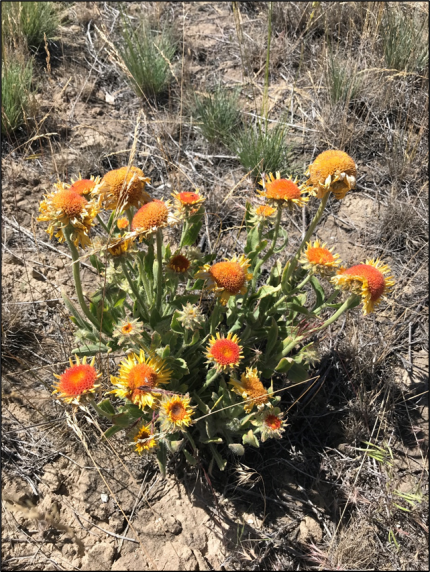
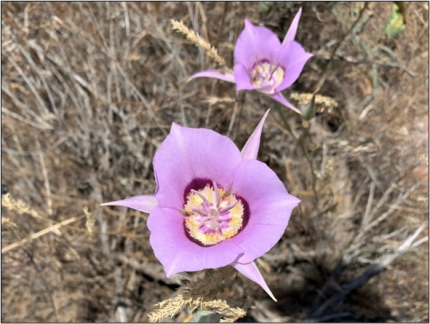
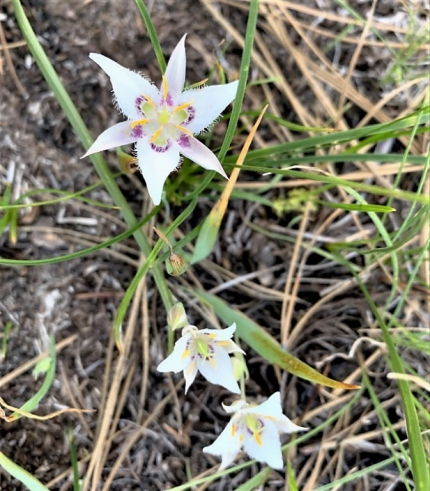
Lands 20/20: Lands Operations Manager Finger wrapped up Lands 20/20 proposals for Douglas and Grant counties. Douglas County proposals included a Phase 4 of Big Bend Wildlife Area which could add up to 4,063 acres for additional conservation habitat to benefit Columbian sharp-tail grouse from two different landowners on the western side of the Big Bend Wildlife Area.
Additionally, a proposal was submitted to acquire several inholdings in the West Foster Creek area with remaining Recreation and Conservation (RCO) funds from the original Big Bend acquisition. For Grant County, Finger submitted a proposal to address legal access issues to about 15 parking areas on Columbia Basin Wildlife Area. Historically, public use of farm roads was supported or at least tolerated. In recent years, that access has been in decline.
Finger submitted a proposal for Columbia Basin Wildlife Area inholdings which are perhaps best categorized by three categories:
- Traditional inholdings which threaten to impact mule deer habitat in the Desert Unit (GMU290).
- Properties existing between county roads and wildlife areas with potential for habitat encroachment and disturbance impacts.
- Properties which bisect heavily used trail systems and intact habitat, with risks to both recreation and habitat connectivity.
Finger also continued information gathering for the next round of Lands 20/20. Proposals will likely move forward for the properties in the Beezley Hills of Grant County, which are very important for pygmy rabbit conservation, and in the White River Unit of Chelan Wildlife Area, where there may be potential to receive Priest Rapids Coordinating Committee funds for an appraisal, then potentially acquisition to acquire lands with significant potential for salmon restoration projects.
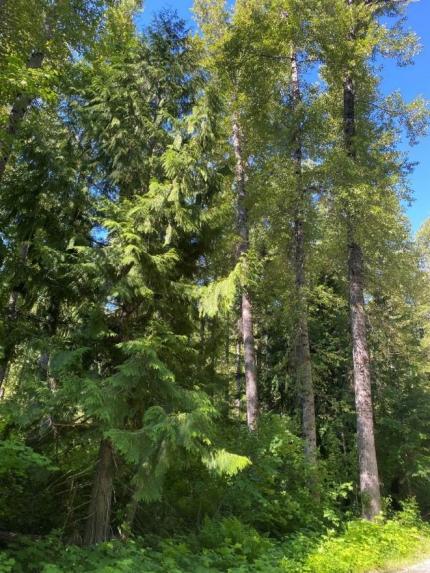
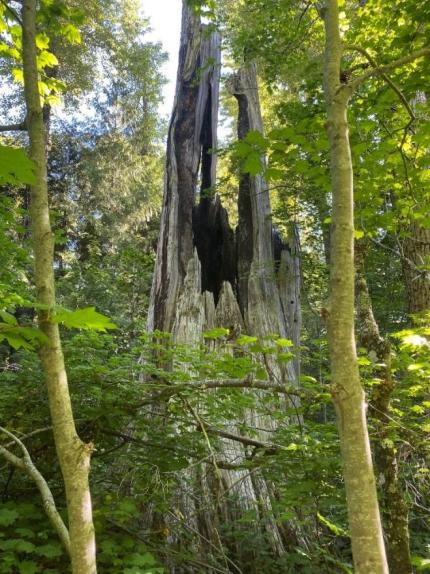
Providing Education and Outreach
Responding to Hunter Calls: Specialist Bridges has been responding to calls from successful special permit holders for the Peshastin and Malaga hunts.
Conducting Business Operations and Policy
Methow Wildlife Area Planning: Staff members held a Wildlife Area Advisory Committee meeting and field trip to Pipestone Canyon. They discussed recreation and trail use. A recreation sub-committee is being formed.
Wildlife area planners held two days of meetings working on the new Methow Wildlife Area management plan. Recreation and travel management were the major topics of the meeting.
Other
Other
Northern Leopard Frogs: Biologist Grabowsky and the Northern leopard frog team have been hard at work to prepare for the upcoming Northern leopard frog (NLF) release that should occur within the next month. Our partners, Oregon Zoo and Northwest Trek, are currently caring for 450 tadpoles that are developing well. Technician Haines has been monitoring the wild site and the tadpoles appear to be developing at a similar rate to those in captivity. The NLF team has been hard at work preparing for releases this summer. A proposal has been approved to construct a bullfrog exclusion fence around our release site to identify the sources of mortality that our reintroduced frogs have been facing since 2019. This project will include tracking both NLF and bullfrogs via telemetry, completing behavioral studies, and performing visual encounter surveys. We hope this will answer some of our questions regarding the efficacy of the reintroduction site and allow us to improve the habitat for future releases.
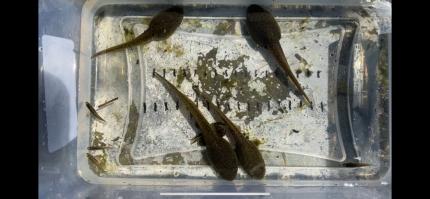
Waterfowl: Biologists Dougherty and Clements and Technicians Gerstenberg and Kleinhenz have been preparing for banding season. This preparation began much earlier this year than in past years, due to increased staff capacity and starting the technicians earlier in the season. The first day of banding will be on July 1 and will continue through September. The early focus will be primarily on mourning doves and then quickly incorporate waterfowl trapping. With the additional staff capacity, we should well surpass past years’ banding efforts.
Additionally, all staff assisted Waterfowl Specialist Wilson to capture resident Canada geese as part of the ongoing banding and population monitoring efforts.
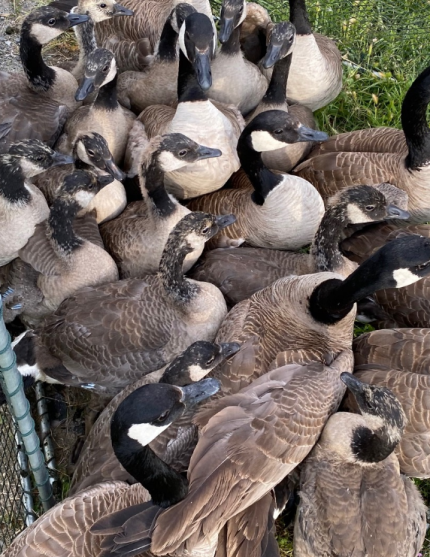
Grebes: Biologist Grabowsky has been monitoring artificial grebe nesting platforms over the past couple weeks. These nest platforms were constructed by Region 2 staff members and deployed at both Banks Lake and Potholes Reservoir where Clarke’s grebe and Western grebe activity tends to be high. Based on observations in June 2022, no grebes appear to be using these platforms for nesting. Grebe nesting activity in general seems to be relatively low compared to 2021 around the same time. No conclusion can be drawn from these observations yet and the platforms will be monitored throughout the summer. This project was implemented to investigate methods to mitigate effects on grebe nesting activity due to fluctuating water levels.
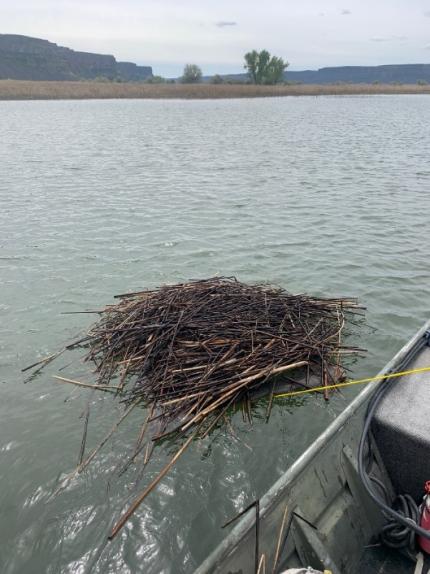
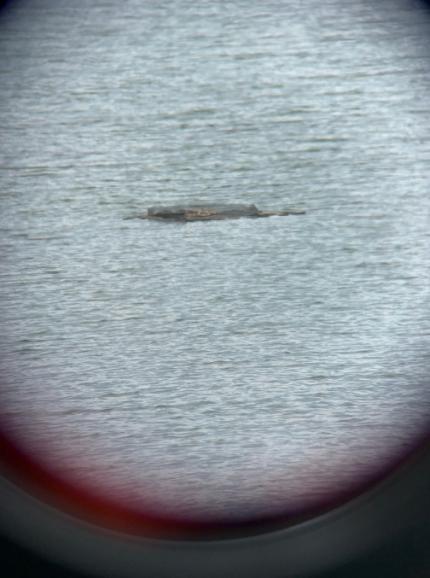
Wolverine Monitoring: Biologist Fitkin continued retrieving cameras deployed with scent attractants this past winter as part of the multi-state wolverine survey effort. This project is a repeat of a similar effort five years ago and is designed to detect trends in wolverine occupancy of modeled habitat in the western states. Unlike five years ago, the Rainy Pass site did not produce any wolverine detections this round, but other secondary target carnivores were detected.
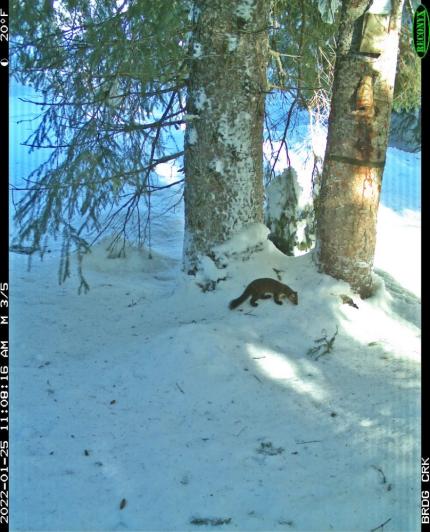
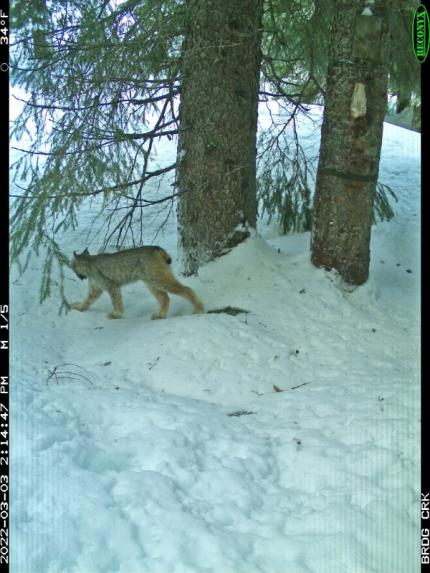
Cougar Research: Biologists Fitkin and Heinlen as well as Research Scientist Kertson assisted some Canadian colleagues in locating the natal den of a cougar in District 6 that was radio-collared in British Columbia.
The young first-time mother had a primary and secondary den in shrubby draws otherwise embedded in a large tract of dry shrub-steppe. Unfortunately, we did not locate any kittens and it appeared, from the evidence on site, that they had been predated by a black bear(s). In fact, our group saw two black bears while searching for the den. In the past, Canadian biologists have followed up on a variety of our study animals that had dispersed north of the border, and it was gratifying to return the favor.
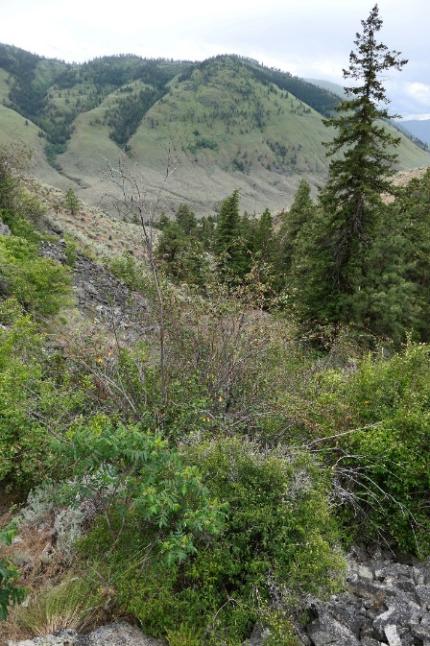
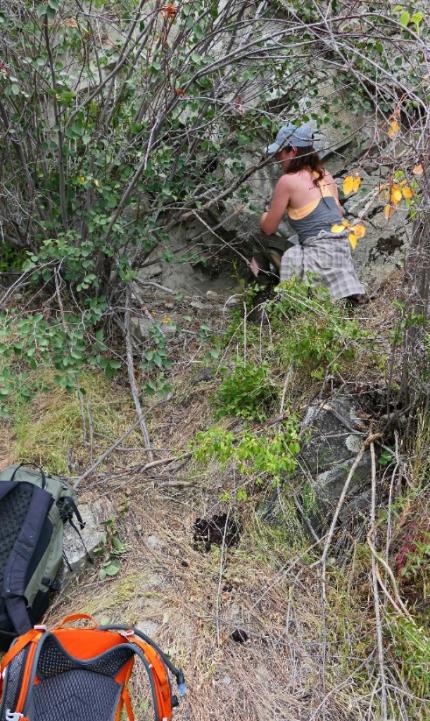
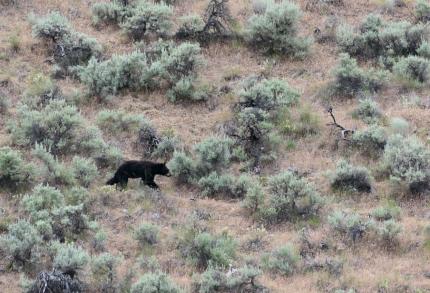
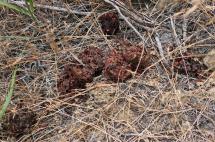
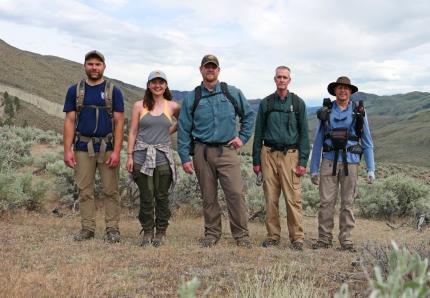
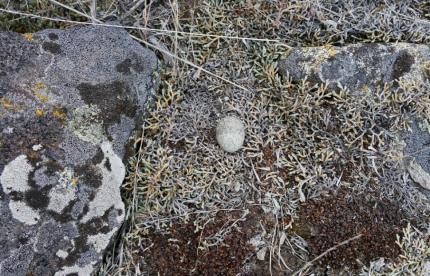
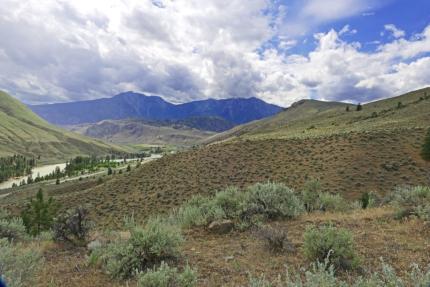
Wildlife Surveys: Biologist Cook assisted the pygmy rabbit crew with the trapping of kits for translocation.
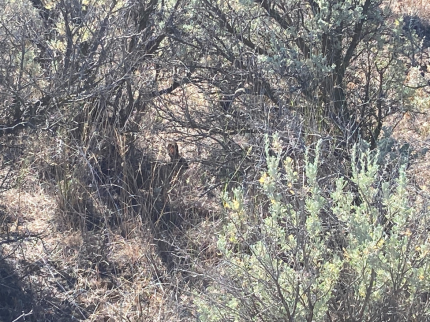
Pygmy Rabbit Release Effort: Kit capture efforts continue this period and productivity is looking good for the enclosure breeding season. We have captured 81 kits thus far (already surpassing last year’s total of 70). We have released 43 juvenile rabbits into the new areas Rimrock Meadows and Palisades, 16 have been retained as future breeding stock, and 19 were too young to relocate and kept in their respective enclosure sites. Each juvenile is vaccinated against rabbit hemorrhagic fever (RHDV2). With above average spring precipitation and unusually cool temperatures, we are hoping this results in a sustained breeding effort.
Monitoring on the release sites is showing good results. The three Rimrock release/acclimation pens look to be doing very well. Rabbits are settling these sites and have begun to dig burrow sites. Rabbit activity and settlement is lower on the three Palisades release sites. We have set up several remote cameras at these sites to get an idea of what they are doing after release.
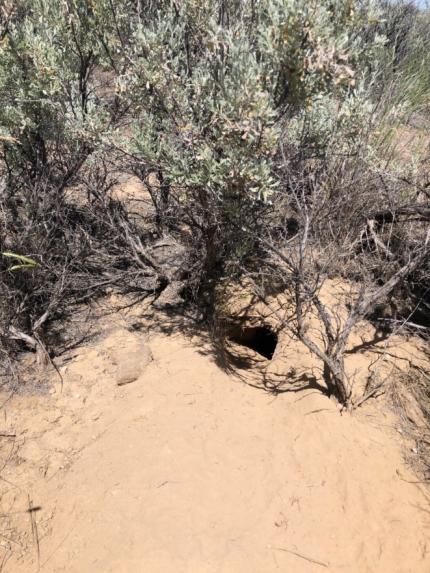
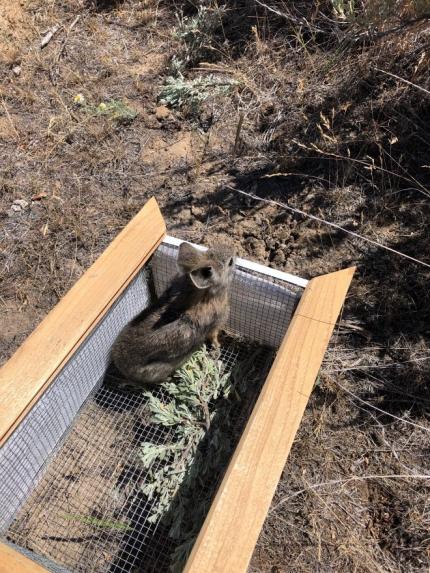
Canada Goose Banding: Science Technician Pavelchek joined State Waterfowl Specialist Wilson and other WDFW biologists to capture and mark Canada geese in several locations across Douglas County, including Rock Island Golf Course, Daroga State Park, and Lake Chelan.
WDFW uses the information collected from hunters who harvest marked geese and birdwatchers who report sightings of marked geese to increase their understanding of the movements of geese relative to urban areas and hunting areas. Waterfowl hunters are asked to report leg band information if they harvest a marked goose. The highly visible collars can be reported by any observer. Reports of band or collar codes, along with locations and dates, should be made to the U.S. Geological Survey Bird Banding Laboratory.
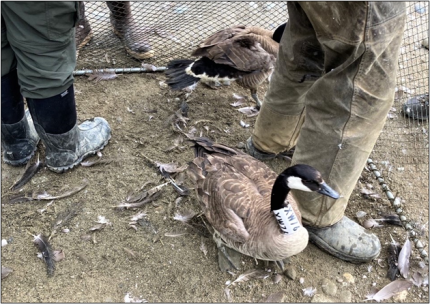
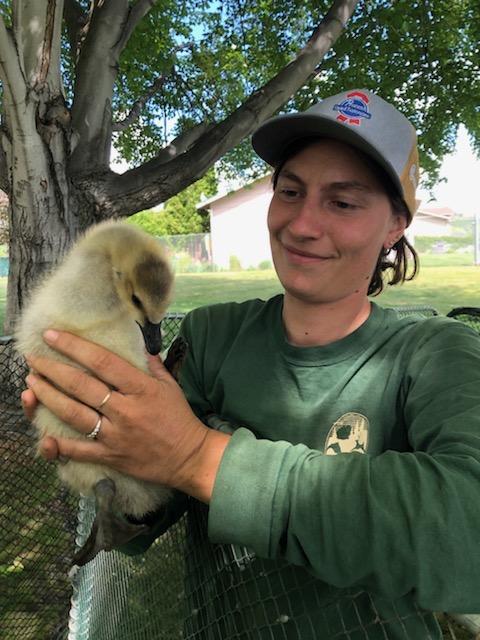
Bumble Bees: Biologist Jeffreys and Scientific Technician Pavelchek conducted bumble bee surveys at Refrigerator Harbor on the shore of Lake Chelan by Lucerne. Although many plants were still flowering, only one bumble bee was observed in the survey grid. This bee was captured and identified as a yellow-faced bumble bee (Bombus vosnesenskii). Habitat data was collected for the grid including identifying and photographing flowering plant (food source) species. This disappointing lack of bumble bees was not limited to the area within the survey grid. Pavelchek and Jeffreys observed only a couple of bees in the surrounding area throughout the duration of their stay. US Forest Service volunteers staying at the Lucerne guard station noted that they had seen very few bumble bees there this year as well.
Despite the underwhelming results, the data collected from this survey were entered into the Pacific Northwest Bumble Bee Atlas online database. The PNW Bumble Bee Atlas is a collaborative effort between WDFW, Idaho Department of Fish and Game, Oregon Department of Fish and Wildlife, and the Xerces Society for Invertebrate Conservation to track and conserve the bumble bees of Washington, Idaho, and Oregon.
Biologists Dougherty and Clements took some time to conduct bumble bee surveys as part of the Pacific Northwest Bumble Bee Atlas and surveyed high priority grids near Ritzville.
Despite lots of flowering resources, biologists were only able to capture one bumble bee.
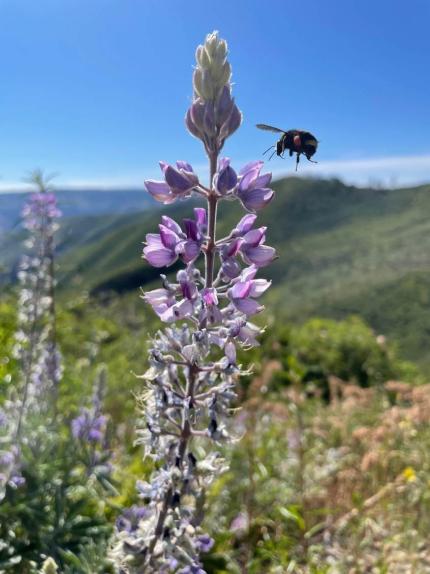
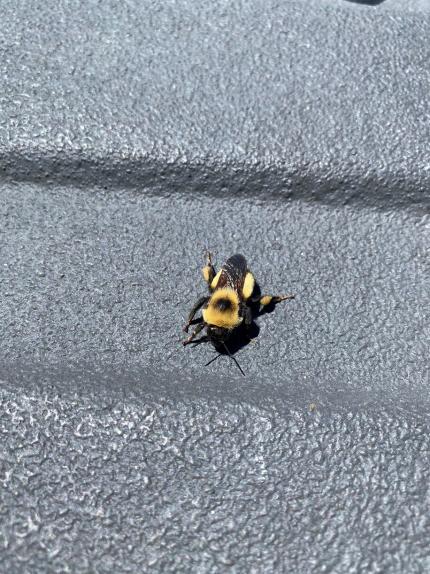
Common Loons: Scientific Technician Pavelchek and Biologist Jeffreys hiked from the Refrigerator Harbor campground at Lucerne up to Domke Lake to follow up on a report from a local that common loons had been breeding at that lake for decades, and had raised young again in the summer of 2021.
This was exciting information as common loons, a WDFW Priority Species and Species of Greatest Conservation Need, have not been documented as breeding in Chelan County for many years. Upon arrival at the lake, Pavelchek and Jeffreys immediately spotted a pair of adult loons foraging very close together.
However, despite prolonged viewing through binoculars and spotting scope, no chicks were observed on or with the adults. At this point in the breeding season, loons that nested successfully would not be moving around the lake without their young, so it is likely that either this pair did not breed or they did breed but the nest failed. There are many potential causes for nest failure including predation, which seems especially likely given the presence of a bald eagle family nesting right on the south shore of the lake.
In an attempt to locate a nest and hopefully gain some insight into whether or not this loon pair did breed but were simply unsuccessful, Jeffreys and Pavelchek boated the entire shoreline of Domke Lake. Much of the shoreline appeared to offer optimal common loon nesting habitat, with plenty of emergent vegetation and many sheltered areas. No obvious nest was found, but it very likely could have been hidden from surveyors’ view. Future years’ surveys for breeding common loons in Chelan County will include Domke Lake.
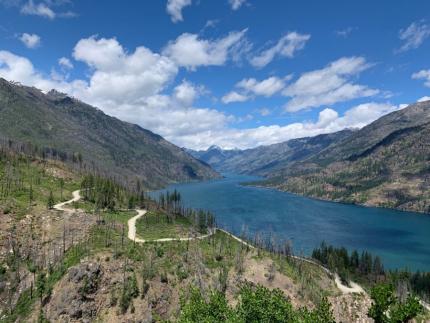
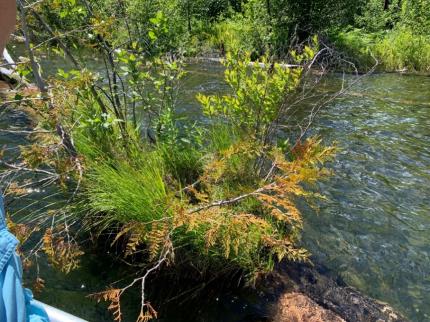
Bat Monitoring: Biologist Jeffreys and Technician Pavelchek deployed four SM4 acoustic detectors at Burch Mountain and in Swakane Canyon as part of a joint effort between WDFW, Northwestern Bat Hub at Oregon State University, and other regional partners. SM4 acoustic detectors record the high frequency vocalizations of bats, allowing for call analysis and species identification. These data will be incorporated into the North American Bat Monitoring Program, which seeks to monitor local and regional bat population trends across the continent and inform effective bat conservation efforts.
Additionally, Jeffreys and Pavelchek conducted an emergence count from some bat boxes in Cole’s Corner, determining that a colony of big brown bats (Eptescus fuscus) occupied one box, and a smaller species, likely little brown myotis (Myotis lucifugus), and/or Yuma myotis (Myotis yumanensis), occupied another.
These sites may be used as part of WDFW’s ongoing white-nose syndrome monitoring effort in the future.
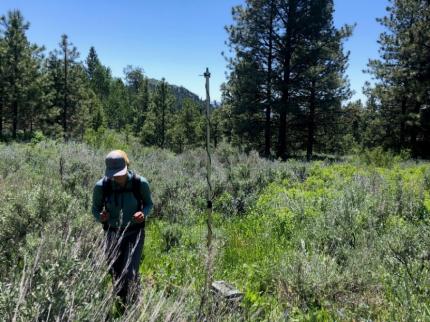
Other
New Assistant District Biologists: District 5 welcomed the new Assistant District Biologist Clements. Biologist Clements joins us from the WDFW pygmy rabbit team where she worked as a scientific technician. She brings important game and nongame wildlife experience to the team, extensive experience working within the Columbia Basin, and enthusiasm to make the most out of this position. Welcome Biologist Clements!
We would also like to welcome Johnna Eilers to the WDFW team as the new assistant district wildlife biologist for District 7. She brings with her a diverse background from teaching Ornithology and Mammalogy labs at Washington State University as well as from her five seasons as a wildlife technician with Utah Division of Wildlife working with birds, bats, pika, prairie dogs, and native fish. She is excited to have the opportunity to work with game species and looks forward to tackling issues and questions relating to harvest and game management.
Meetings: Biologist Morris attended a Pheasants Forever board meeting with the Big Bend Pheasants Forever chapter. He met the recently hired Pheasants Forever private lands biologist, who is working out of the Natural Resources Conservation Service office in Ephrata. He also coordinated with the chapter on potential habitat projects. This valuable relationship facilitates for numerous habitat restoration projects with private funding to match state and federal funds to increase the capacity for projects.
Managing Wildlife Populations
Burrowing Owl Artificial Burrow Project: District 4 Wildlife Biologist Fidorra monitored and banded burrowing owls as part of an ongoing research project utilizing artificial burrows. Fidorra got help from Assistant District 8 Biologist Wampole and Region 2 technicians during this period to band and trap adults and nestlings in the artificial burrows. Fidorra also assisted US Fish and Wildlife Services with monitoring and banding at their Paterson Unit where owls are using the burrows for the first time in several years! Fidorra also toured the Energy Northwest Powerplant property where 8 clusters of artificial burrows were created. This is the first time WDFW has been to the site, and while the burrows were in good order, no owls were nesting this season.
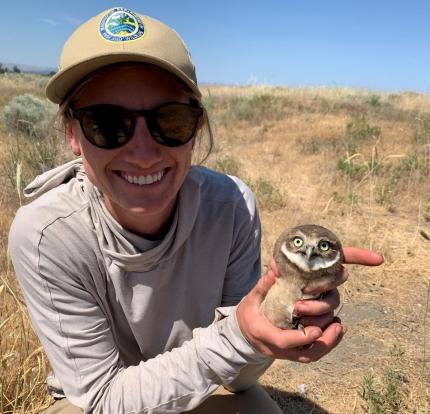
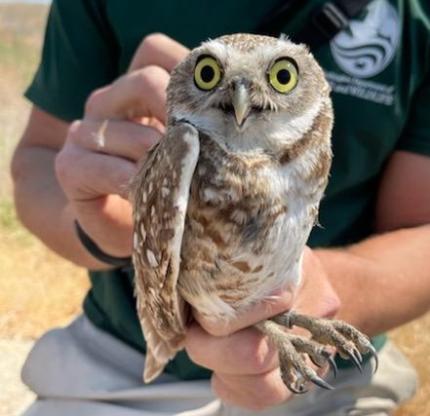
Burrowing Owl Transmitter Project: District 4 Wildlife Biologist Fidorra worked with University of Idaho Researcher Conway to deploy and test new solar tracking devices GPS accuracy on burrowing owls in Pasco. Fidorra also deployed trail cameras onsite to monitor the adults to make sure the harness and transmitter package worked without impacting the owls.
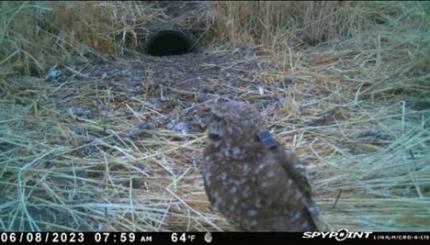
Fisher Monitoring: District 8 Wildlife Biologist Wampole began retrieving fisher monitoring sites that were placed in fall 2022. Sites were left over winter and spring to monitor for fisher occupancy and is part of a large effort across the southern Cascades to evaluate the status of fisher following reintroductions.
Bear Monitoring: Bear monitoring sites were installed in portions of the Oak Creek Wildlife Area and the Okanogen-Wenatchee National Forest in District 8. Sites are designed to capture hair from curious bears in the area using barbed wire strung around a stand of trees with a scent lure in the center. DNA analysis will be conducted on hair samples and used to estimate bear density in the area. This monitoring effort is led by Statewide Bear and Cougar Specialists Beausoleil and Welflet.
Pelican and Tern Colony Monitoring: District 4 Wildlife Biologist Fidorra and US Fish and Wildlife Service McNary and WDFW staff members joined the Real Time Research contractors for a boat based colony survey of terns, gulls, and white pelicans on the Columbia River. Some of the first fledglings of the year were detected. Fidorra also worked on analysis of aerial colony images taken by WDFW in May, for the annual adult pelican count on Badger Island.
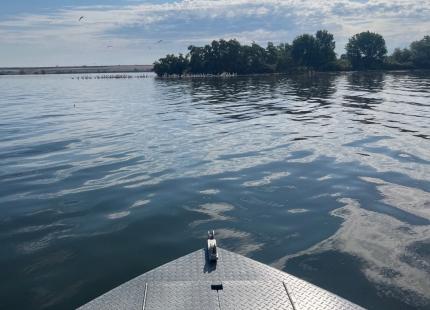
Tri-Cities Goose Banding: District 4 Wildlife Conflict Specialist Hand, Private Lands Biologist Hulett and Technician Manderbach participated in a goose round-up and banding project at Columbia Park in Kennewick.
Blue Mountain Elk Collaring: Sunnyside-Snake River Manager Kaelber assisted WDFW staff members and others with collaring elk calves in the Blue Mountains for a calf survival study.
State Wildlife Action Plan Process Review: District 4 Wildlife Biologist Fidorra provided comments and attended the State Wildlife Action Plan (SWAP) process review meeting in preparation for the 2025 SWAP update. The process outlined how species would be selected for inclusion in the SWAP as Species of Greatest Conservation Need.
Blue Mountains Elk Collaring: Colockum Wildlife Area Manager Lopushinsky and Assistant Manager Hagan also assisted WDFW staff members and others with collaring elk calves in the Blue Mountains for a calf survival study. Staff members worked in rugged terrain spotting cow elk with calves and then hiking to get close enough to capture and collar newborn calves.
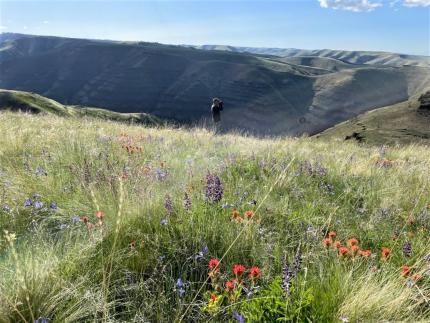
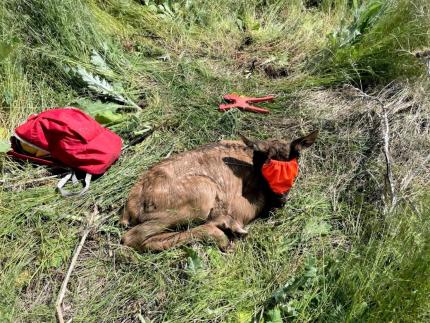

Providing Conflict Prevention and Education
Reducing Vehicle Collisions: District 8 Habitat and Wildlife staff members, met with a Washington Department of Transportation biologist and engineers to begin discussion of our prospects for safe passage of wildlife to reduce wildlife vehicle collisions and improve connectivity.
Bear Cub Orphan: District 8 Wildlife staff members and police responded to a report of an orphaned bear cub on private land. The 3–4-month male cub was safely located, captured, and transported to a wildlife rehabilitation facility. The cub was determined to be in good condition and is slated for release in spring 2024.
Rattlesnake Hills Elk: District 4 Wildlife Conflict Specialist Hand continues to monitor elk activity and damage impacts while actively preforming late night/early morning hazing patrols. As natural forage dries-out and crop fields mature, increasing numbers of elk continue to raid wheat fields along the top of Rattlesnake Mountain, mostly during nocturnal hours.
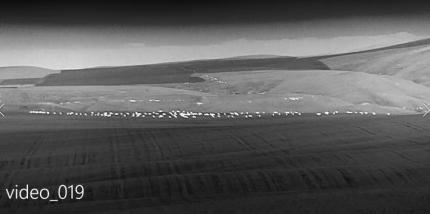
Richland Coyote: District 4 Wildlife Conflict Specialist Hand responded to a complaint from a homeowner near Badger Mountain concerning a coyote that was hanging around residences. “Living with Wildlife” material was discussed as well as actions that can be taken to protect pets.
Conserving Natural Landscapes
Diffuse Knapweed Control: Oak Creek Technician Boggs and Assistant Manager Charlet released biocontrol insects (bangasternus farsti) to help control dense diffuse knapweed patches in the Cowiche Unit of the Oak Creek Wildlife Area. Biocontrol insects were provided by the Washington State University Extension as part of the integrated weed control project.
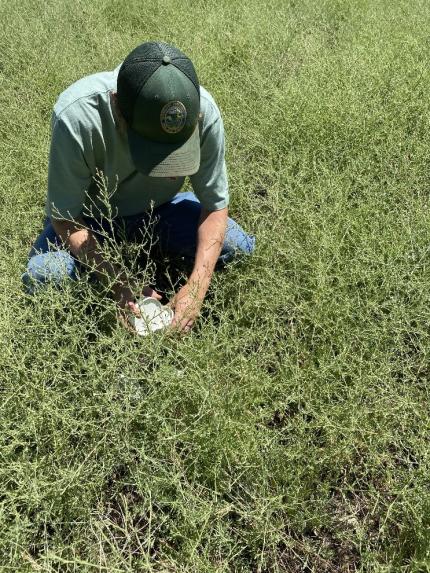

Sunnyside/Snake River Weed Control: Manager Kaelber and Technician Manderbach removed large patches of Scotch thistle from the I-82 Ponds Unit. Sunnyside/Snake River Wildlife Area staff members continue to apply integrated pest management strategies to control invasive weeds throughout the wildlife area.
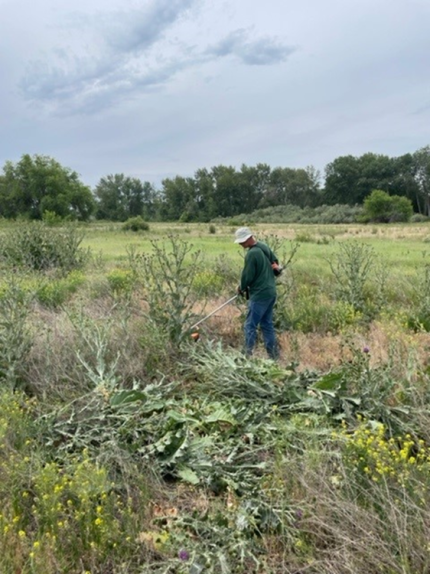
Providing Education and Outreach
Public Presentation Deer and Elk: Assistant District 8 Biologist Wampole presented to the Kittitas Field and Streams Club on the status and trends of the elk and deer in District 8 and answered questions regarding concerns around mule deer and elk in the area.
Mesa Elementary Ecology Day: Assistant Manager Jahns attended Mesa Elementary School’s Ecology Day. The entire K-6 student body rotated through different educational stations throughout the day learning about all things ecology! The students were very enthusiastic about Washington Department of Fish and Wildlife. It was a fun, action-packed day of learning!
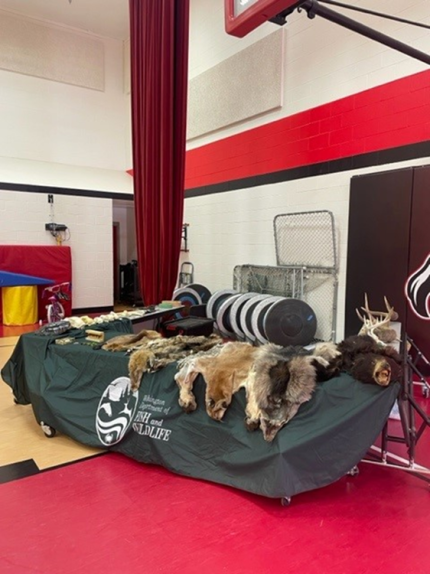
Other
District 4 staff members in Pasco prepared for the furniture update of desks and cabinets expected in the coming week. Wildlife Biologist Fidorra worked to secure a contract with moving companies while everyone cleaned and prepped to remove old furniture once the new arrives.
Managing Wildlife Populations
Blue Mountain Elk Captures: Biologists Holman traveled to southeastern Washington to assist District 3 and Game Division staff with calf elk captures in the Blue Mountains. The neonate elk are being studied to better understand the dynamics behind declining elk populations in the Blues. The work involves traveling to spotting locations on high ground early in the morning, spotting cow elk, locating their calves, watching until the calves bed, traversing to the exact location of the calf which is often one to two miles in the distance, hand capturing the calf, installing a GPS/VHF collar and taking biological measurements, then releasing the calf. The young elk are strongly precocial and are very capable of escaping capture when they reach no more than a few days of age.
Many individuals participated in the effort. These included University of Idaho Associate Professor Christensen, University of Idaho Student Interns Sam and Adan, WDFW biologists, researchers, and wildlife area managers from other parts of the state, U.S. Fish and Wildlife Service (USFWS) Biologist Kruenegel, along with others. A special guest and participant in the effort within GMU 175 (Lick Creek), was Fish and Wildlife Commissioner Anderson who spent two full days applying his field skills and energy to the project.
Thanks to District Biologist Wik and Ungulate Specialist Moore for their organization and dedication to the success of this project. Finally, special thanks and appreciation to Fish and Wildlife Commissioner Anderson for his willingness to spend long hours in the field with staff members, discussing the complexities of wildlife management, and sharing his stories of a lifetime of involvement in the management of Washington’s natural resources.
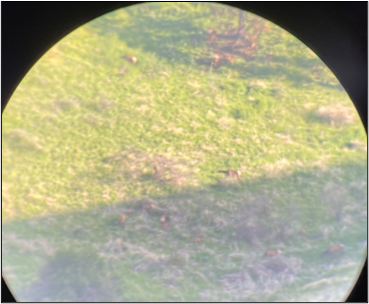
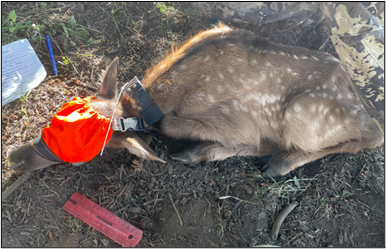
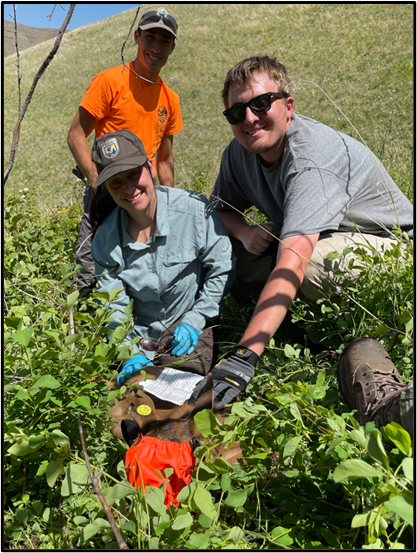
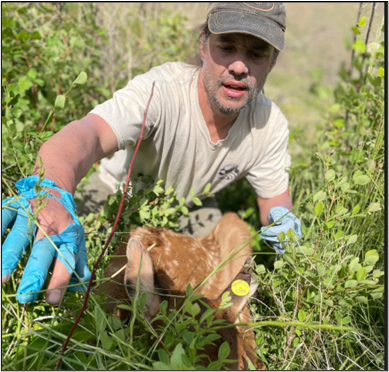
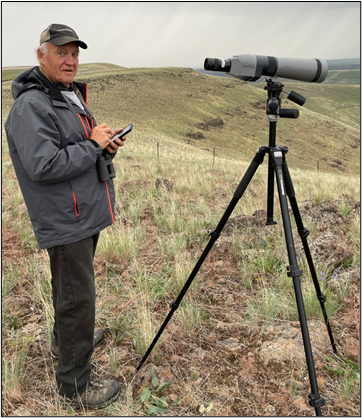
Catching Turtle Hatchlings for Headstarting: For several days over the last two months, Biologists Wickhem and Bergh and Technician Motiff have dedicated a significant amount of time to catching hatchling northwestern pond turtles at a site in Klickitat County. The hatchlings were sent to the Oregon Zoo in Portland where they will grow in the safety of captivity during their most vulnerable life stage. Next spring, they will be released back into their native habitat at a size that allows them to escape predation more easily. Northwestern pond turtles are state endangered and unfortunately in the wild, hatchlings are often eaten by American bullfrogs and other non-native predators. The headstart program is one tool WDFW and partners are using to aid in the recovery of pond turtle populations in Washington. For more information on the headstart program, please visit the Oregon Zoo’s website.
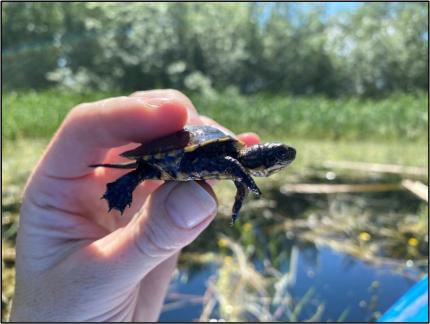
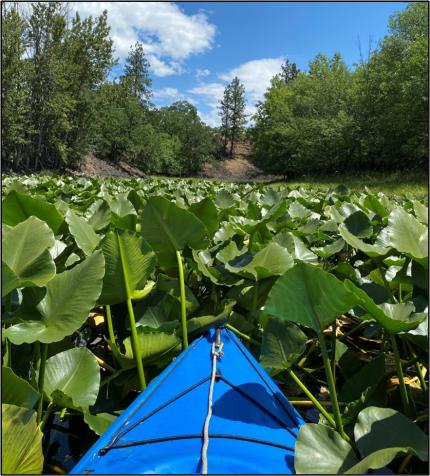
Sandhill Crane Monitoring: Biologist Bergh and Technician Motiff joined a landowner for a sandhill crane survey. The group spotted what looked to be a nesting crane and Technician Motiff came back the following day and confirmed the nest by observing a nest exchange (where the adults switch and take turns incubating the nest). Biologist Bergh and the landowner went out a month later to attempt to find the nest after the eggs should have hatched. When they neared where the nest should be they bumped into an adult crane. The crane then tried to get them to follow it. It was likely trying to protect a nearby colt, a newly hatched sandhill crane, but the landowner will be on the lookout to see if a colt is observed.
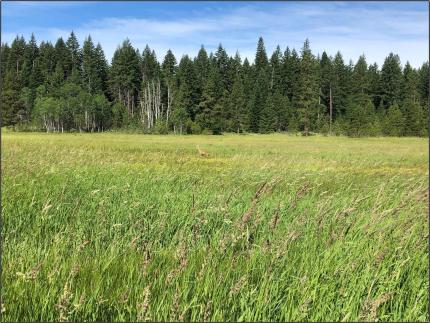
Conserving Natural Landscapes
Mt. St. Helens Wildlife Area: Over two days, volunteers from Rocky Mountain Elk Foundation and the WDFW Master Hunter Program put in a solid 400 hours of labor to remove Scotch broom across 230 acres and cage 150 native trees and shrubs on the Mudflow Unit of the Mt. St. Helens Wildlife Area. The efforts of these volunteers over the past several years has resulted in a significant reduction of Scotch broom on the Mudflow, greatly improving habitat for elk and other species of wildlife that utilize the Wildlife Area. Their efforts and dedication are greatly appreciated, not only by the Wildlife Program, but by the Washington Department of Fish and Wildlife as a whole.
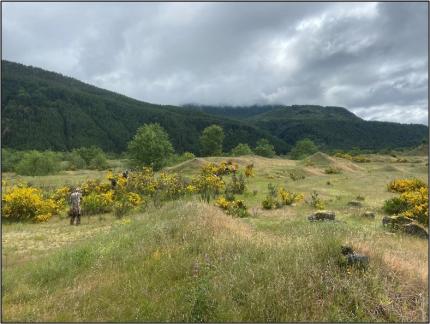
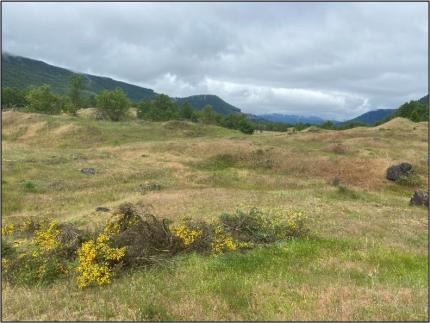
Bluebird Nest Box Survey: The bluebird nest boxes on the Soda Springs Unit were surveyed for occupancy. Most of the boxes were being used by western bluebirds, but other birds were present in some of them. Of the 26 serviceable boxes, 12 were occupied by bluebirds, two were occupied by tree swallows, two were being used by violet-green swallows, three contained mountain chickadee nests, and seven boxes were unused. All the nest boxes are located along the Grayback and Sheep Canyon roads or along the Glenwood Highway, where they can be observed by visitors to the Klickitat Wildlife Area.
Seasonal Burn Ban in Effect at Leidl Park, Stinson Flat, Mineral Springs, and Turkey Hole Campgrounds: On June 5, Klickitat County implemented a seasonal burn ban for the part of the county identified as Zone 2. The campgrounds along the Klickitat River follow the county’s Zone 2 burn ban schedule, and signs were posted to advise visitors of the seasonal restriction on campfires.
Managing Wildlife Populations
Sooty Grouse Population Monitoring: Biologist Tirhi completed the last sooty grouse survey for this year within the assigned survey routes for District 11. This survey, done June 13, is technically past the survey window (March-May) but the district was only able to get one survey completed on one route this season, so Tirhi decided to attempt one other. No grouse were seen or heard, lending support that the height of the calling season has now passed. This is a new survey approach and the time the district had available for sooty grouse was spent locating and setting up the routes (for the future) and getting equipment deployed. Tirhi spent time following the survey finalizing another route for next season. District 11 was encouraged to establish and survey:
- Three routes have been fully established.
- Two surveys were conducted to protocol.
- Three acoustic monitors were deployed.
- One route was shelved for tribe to conduct in 2024 since it’s on tribal land.
- One route was eliminated due to lack of access. It is behind a private gate.
- One route has been defined but needs listening stations added.
- One route is partially established but needs completion and listening stations.
Deer and Elk Collaring: Biologist Murphie helped the Makah Wildlife Program in their efforts to collar juvenile deer and elk. This effort will provide insight into fawn and calf survival in the study area. Murphie reports several being captured, and they are close to meeting project objectives for this session.
Western Pond Turtle: Biologist Murphie deployed two artificial basking structures at the western pond turtle recovery site in District 15. A PIT tag (passive integrated transponder) antenna array was received and will be fitted to a platform next week. We hope to identify which turtles released into the pond are still present.
Taylor’s Checkerspot Butterfly: Biologist Murphie conducted the last of this season’s survey effort during this reporting period. Overall, the counts were considerably lower than expected.
Bear Hair-Snare Project: Biologist Murphie along with carnivore section staff members set up 36 stations in Game Management Unit (GMU) 636 to collect hair samples from bears over the next few weeks. The first check was also completed and Biologist Murphie reports that hair samples were collected from 17 of the 36 stations. On camera visitors included a turkey vulture, deer, squirrel, bobcat, spotted skunk, and a few bears. More to come, as this project is conducted.
Providing Recreation Opportunities
Management Planning: Biologist Tirhi worked on various management planning documents and participated in planning meetings including the Scatter Creek Wildlife Area Habitat Management Plan and the Game Management Plan update (elk section).
Conserving Natural Landscapes
Protection Island: Noxious Weed Coordinator Heimer, Prairie Specialist Cook, and Wildlife Area Manager Laushman visited Protection Island, part of the North Olympic Wildlife Area, to assess next steps for invasive species control on the island.
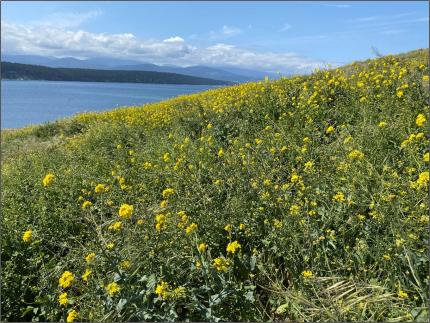
Union River: Noxious Weed Coordinator Heimer and Wildlife Area Manager Laushman met with members of the Pierce Conservation District at the South Puget Sound Unit in Lakewood to discuss potential riparian restoration work along Chambers Creek.
Bell Creek: Technician Morgan mowed annual grasses along the boundary of the Oak Restoration Project at the Bell Creek Unit in Sequim, of the North Olympic Wildlife Area. The mowing is in response to fire concerns related to upcoming community fireworks display in a neighboring park.
Union River: Wildlife Area Manager Laushman toured the Union River Wildlife Area Unit in Belfair to discuss upcoming potential estuary restoration work with biologists from the Habitat Program and partner organizations.
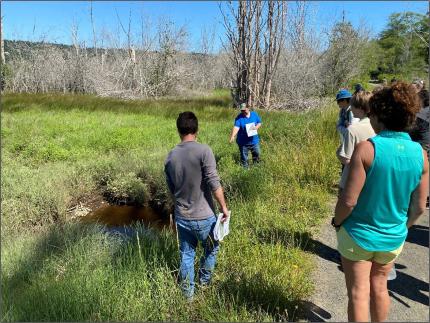
Providing Education and Outreach
General Wildlife Inquiries: Biologist Murphie responded to inquiries received by phone, email, or in person related to mystery scat, deer, bear, waterfowl hunting and elk hunting.















